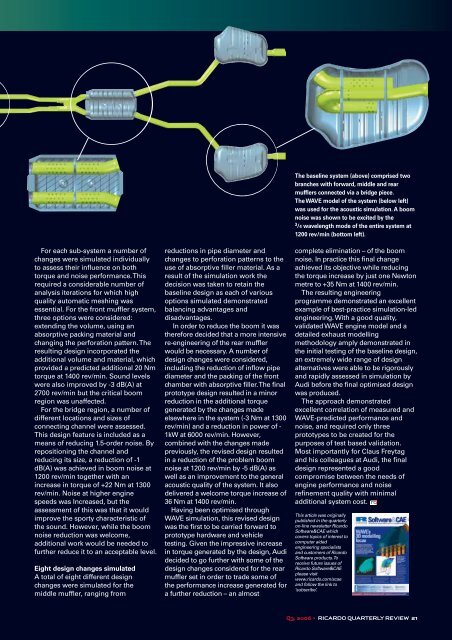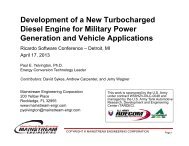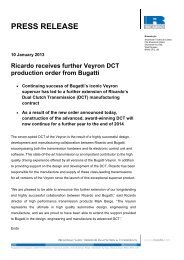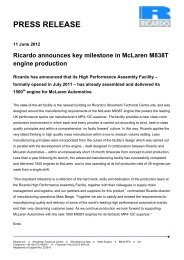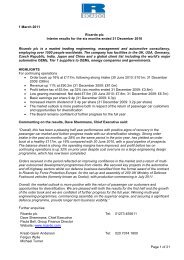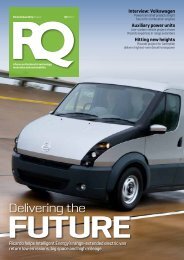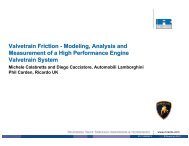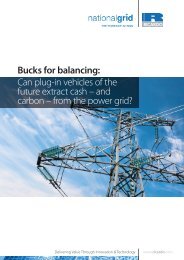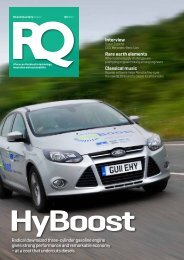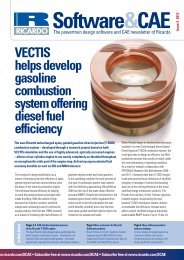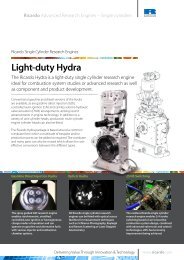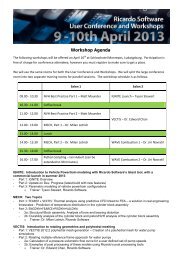The hottest - Ricardo
The hottest - Ricardo
The hottest - Ricardo
Create successful ePaper yourself
Turn your PDF publications into a flip-book with our unique Google optimized e-Paper software.
For each sub-system a number of<br />
changes were simulated individually<br />
to assess their influence on both<br />
torque and noise performance. This<br />
required a considerable number of<br />
analysis iterations for which high<br />
quality automatic meshing was<br />
essential. For the front muffler system,<br />
three options were considered:<br />
extending the volume, using an<br />
absorptive packing material and<br />
changing the perforation pattern. <strong>The</strong><br />
resulting design incorporated the<br />
additional volume and material, which<br />
provided a predicted additional 20 Nm<br />
torque at 1400 rev/min. Sound levels<br />
were also improved by -3 dB(A) at<br />
2700 rev/min but the critical boom<br />
region was unaffected.<br />
For the bridge region, a number of<br />
different locations and sizes of<br />
connecting channel were assessed.<br />
This design feature is included as a<br />
means of reducing 1.5-order noise. By<br />
repositioning the channel and<br />
reducing its size, a reduction of -1<br />
dB(A) was achieved in boom noise at<br />
1200 rev/min together with an<br />
increase in torque of +22 Nm at 1300<br />
rev/min. Noise at higher engine<br />
speeds was Increased, but the<br />
assessment of this was that it would<br />
improve the sporty characteristic of<br />
the sound. However, while the boom<br />
noise reduction was welcome,<br />
additional work would be needed to<br />
further reduce it to an acceptable level.<br />
Eight design changes simulated<br />
A total of eight different design<br />
changes were simulated for the<br />
middle muffler, ranging from<br />
reductions in pipe diameter and<br />
changes to perforation patterns to the<br />
use of absorptive filler material. As a<br />
result of the simulation work the<br />
decision was taken to retain the<br />
baseline design as each of various<br />
options simulated demonstrated<br />
balancing advantages and<br />
disadvantages.<br />
In order to reduce the boom it was<br />
therefore decided that a more intensive<br />
re-engineering of the rear muffler<br />
would be necessary. A number of<br />
design changes were considered,<br />
including the reduction of inflow pipe<br />
diameter and the packing of the front<br />
chamber with absorptive filler. <strong>The</strong> final<br />
prototype design resulted in a minor<br />
reduction in the additional torque<br />
generated by the changes made<br />
elsewhere in the system (-3 Nm at 1300<br />
rev/min) and a reduction in power of -<br />
1kW at 6000 rev/min. However,<br />
combined with the changes made<br />
previously, the revised design resulted<br />
in a reduction of the problem boom<br />
noise at 1200 rev/min by -5 dB(A) as<br />
well as an improvement to the general<br />
acoustic quality of the system. It also<br />
delivered a welcome torque increase of<br />
36 Nm at 1400 rev/min.<br />
Having been optimised through<br />
WAVE simulation, this revised design<br />
was the first to be carried forward to<br />
prototype hardware and vehicle<br />
testing. Given the impressive increase<br />
in torque generated by the design, Audi<br />
decided to go further with some of the<br />
design changes considered for the rear<br />
muffler set in order to trade some of<br />
the performance increase generated for<br />
a further reduction – an almost<br />
<strong>The</strong> baseline system (above) comprised two<br />
branches with forward, middle and rear<br />
mufflers connected via a bridge piece.<br />
<strong>The</strong> WAVE model of the system (below left)<br />
was used for the acoustic simulation. A boom<br />
noise was shown to be excited by the<br />
3 /4 wavelength mode of the entire system at<br />
1200 rev/min (bottom left).<br />
complete elimination – of the boom<br />
noise. In practice this final change<br />
achieved its objective while reducing<br />
the torque increase by just one Newton<br />
metre to +35 Nm at 1400 rev/min.<br />
<strong>The</strong> resulting engineering<br />
programme demonstrated an excellent<br />
example of best-practice simulation-led<br />
engineering. With a good quality,<br />
validated WAVE engine model and a<br />
detailed exhaust modelling<br />
methodology amply demonstrated in<br />
the initial testing of the baseline design,<br />
an extremely wide range of design<br />
alternatives were able to be rigorously<br />
and rapidly assessed in simulation by<br />
Audi before the final optimised design<br />
was produced.<br />
<strong>The</strong> approach demonstrated<br />
excellent correlation of measured and<br />
WAVE-predicted performance and<br />
noise, and required only three<br />
prototypes to be created for the<br />
purposes of test based validation.<br />
Most importantly for Claus Freytag<br />
and his colleagues at Audi, the final<br />
design represented a good<br />
compromise between the needs of<br />
engine performance and noise<br />
refinement quality with minimal<br />
additional system cost.<br />
This article was originally<br />
published in the quarterly<br />
on-line newsletter <strong>Ricardo</strong><br />
Software&CAE which<br />
covers topics of interest to<br />
computer aided<br />
engineering specialists<br />
and customers of <strong>Ricardo</strong><br />
Software products. To<br />
receive future issues of<br />
<strong>Ricardo</strong> Software&CAE<br />
please visit<br />
www.ricardo.com/scae<br />
and follow the link to<br />
‘subscribe’.<br />
Q3, 2006 • RICARDO QUARTERLY REVIEW 21


